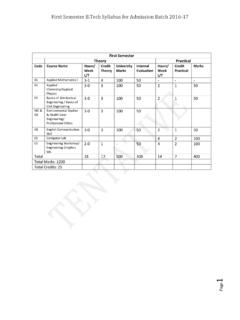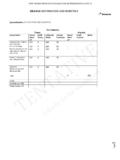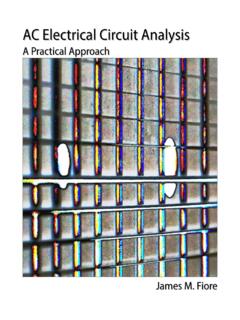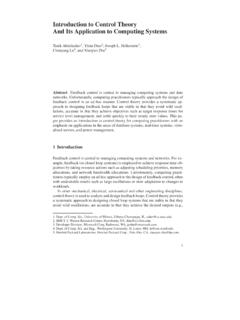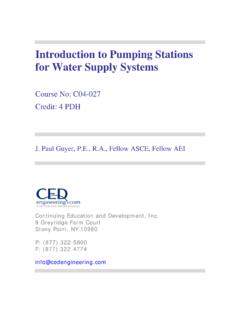Transcription of Chapter-1 Introduction to Engineering Materials
1 MODULE I (16 Lectures) Classification of Engineering Materials , Engineering properties of Materials . Characteristic property of metals, bonding in solids, primary bonds like ionic, covalent and metallic bond, crystal systems, common crystal structure of metals, representations of planes and directions in crystals, atomic packing in crystals, calculation of packing density, voids in common crystal structures and imperfections crystals. Chapter- 1 introduction to Engineering Materials Introduction Materials play an important role for our existence, for our day to day needs ,and even for our survival.
2 In the stone age the naturally accessible Materials were stone, wood, bone, fur etc Gold was the 1st metal used by the mankind followed by copper. In the bronze age Copper and its alloy like bronze was used and in the iron age they discovered Iron (sponge iron & later pig iron). 1960 s Engineering Materials Metals Design Choice of Material New Materials New Products Number of Materials 40 80,000!
3 General Definition of Material According to Webster s dictionary, Materials are defined as substances of which something is composed or made Engineering Material: Part of inanimate matter, which is useful to engineer in the practice of his profession (used to produce products according to the needs and demand of society) Material Science: Primarily concerned with the search for basic knowledge about internal structure, properties and processing of Materials and their complex interactions/relationships Material Engineering : Mainly concerned with the use of fundamental and applied knowledge of Materials , so that they may be converted into products, as needed or desired by the society (bridges Materials knowledge from basic sciences to Engineering disciplines) Note.
4 Material science is the basic knowledge end of Materials knowledge spectrum, where as, material Engineering is applied knowledge end and there is no demarcation line between the two subjects of interest Evolution of Engineering Materials Why Material Science & Engineering is important to technologists? Examples: Mechanical engineers search for high temp material so that gas turbines, jet engines etc can operate more efficiently and wear resistance Materials to manufacture bearing Materials Electrical engineers search for Materials by which electrical devices or machines can be operated at a faster rate with minimum power losses Aerospace & automobile engineers search for Materials having high strength-to-weight ratio Electronic engineers search for material that are useful in the fabrication & miniaturization of electronic devices Chemical engineers search for highly
5 Corrosion-resistant Materials Note: All these demands may be fulfilled when the internal structure and Engineering properties are known to an engineer or technologist Classification It is the systematic arrangement or division of Materials into groups on the basis of some common characteristic 1. According to General Properties 2. According to Nature of Materials 3. According to Applications 1. According to General Properties (a). Metals ( iron, aluminium, copper, zinc, lead, etc) Iron as the base metal, and range from plain carbon (> 98 % Fe) to (i).
6 Ferrous: high alloy steel (< 50 % alloying elements), cast iron, wrought iron, steel, alloys like high-speed steel, spring steel, etc (ii). Non-Ferrous: Rest of the all other metals and their alloys, copper, aluminium, zinc lead, alloys like brass, bronze, duralumin, etc (b). Non-Metals ( leather, rubber, asbestos, plastics, etc) 2. According to Nature of Materials (a). Metals: Iron & Steel, Alloys &Superalloys, Intermetallic Compounds, etc (b). Ceramics: Structural Ceramics (high-temperature load bearing), Refractories (corrosion-resistant, insulating), Whitewares (porcelains), Glass, Electrical Ceramics (capacitors, insulators, transducers), Chemically Bonded Ceramics (cement & concrete) (c).
7 Polymers: Plastics, Liquid Crystals, Adhesives (d). Electronic Materials : Silicon, Germanium, Photonic Materials (solid-state lasers, LEDs) (e). Composites: Particulate composites (small particles embedded in a different material), Laminate composites (golf club shafts, tennis rackets), Fiber reinforced composites (fiberglass) (f). Biomaterials: Man-made proteins (artificial bacterium), Biosensors, etc (g). Advanced / Smart Materials : Materials in computers (VCRs, CD Players, etc), fibreoptic systems, spacecrafts, aircrafts, rockets, shape-memory alloys, piezoelectric ceramics, magnetostrictive Materials , optical fibres, microelectromechanical (MEMs) devices, electrorheological / magnetorheological fluids, Nanomaterials, etc 3.
8 According to Applications (a). Electrical Materials : conductors, insulators, dielectrics, etc (b). Electronic Materials : conductors, semi-conductors, etc (c). Magnetic Materials : ferromagnetic, paramagnetic & diamagnetic Materials , etc (d). Optical Materials : glass, quartz, etc (e). Bio Materials : man-made proteins, artificial bacterium EngineeringMaterials Ceramics Alumina Diamond Magnesia Silicon Carbide Zirconia Composites Carbon Fiber Ceramic Matrix Glass Fiber Metal Matrix Electronic Materials Silicon Germanium Photonic Materials Solid-State Lasers LEDs Bio- Materials Man-Made Proteins Artificial Bacterium Biosensors Advanced / Smart Materials Shape-Memory Alloys Piezoelectric Ceramics Magnetostrictive Materials Optical Fibres Electrorheological Fluids Nanomaterials Metals Ferrous
9 Non-Ferrous Cast Iron Carbon Steels Alloy Steels Stainless Steels Aluminium Brass Bronze Copper Lead Magnesium Nickel Tin Zinc Titanium Polymers Thermoplastic ThermosettingElastomers ABS Acrylic Nylon Polyethylene Polystyrene Vinyl Epoxy Phenolic Polyester Butyl Fluorocarbon Neoprene Rubber Silicone Difference between Metals & Non-Metals 1. Material Properties Physical: appearance, shape, weight, boiling point, melting point, freezing point, density, glass transition temperature, permeability Mechanical: strength (tensile, compressive, shear, torsion, bending), elasticity, plasticity, ductility, malleability, rigidity, toughness, hardness, brittleness, impact, fatigue, creep, strain hardening, Bauschinger effect, strain rate effect, vibration resistance, wear Thermal.
10 Thermal conductivity, expansion coefficient, resistivity, thermal shock resistance, thermal diffusivity Property Metals Non-Metals Structure Crystalline Amorphic State Generally solids at room temp. Gaseous & solid at ordinary temp. Luster Metallic luster No metallic luster (except iodine & graphite) Conductivity Good conductors of heat & electricity Bad conductors Malleability Malleable Not malleable Ductility Ductile Not ductile Hardness Generally hard Hardness varies Electrolysis Form anions Form anioins Excitation of valence electron by Easy Difficult Density High Low Electrical.

